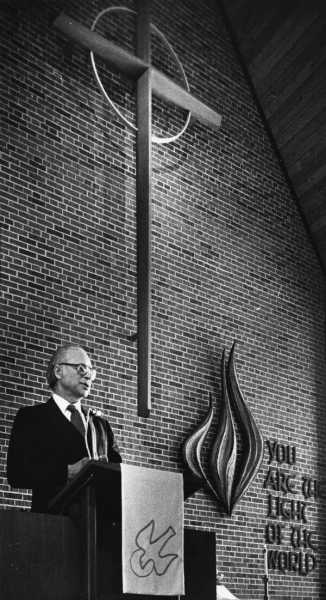As a Republican member of the House of Representatives from Minnesota and as the state’s governor, he became identified with Christian piety and limited government.
- Share full article

Albert Quie delivering the Thanksgiving Day sermon at Chapel Hills United Church of Christ in Edina, Minn., shortly after the end of his first and only term as governor of Minnesota.
Albert Quie, a Minnesota dairy farmer who became a member of the House of Representatives and the governor of his state — and who made Christian piety and fiscal conservatism the core of his political identity in the 1970s, before that was the standard model for Republicans — died on Friday at his home in Wayzata, a suburb of Minneapolis. He was 99.
Gov. Tim Walz of Minnesota announced the death on X, the social media platform formerly known as Twitter.
In 1974, The New York Times wrote about Mr. Quie (pronounced kwee) as a central participant in an ascendant phenomenon in the nation’s capital: the power prayer group.
“The corner on pietism in Washington has long appeared to be held by pressure groups, chanting and praying from the fringes,” John Deedy, the managing editor of Commonweal magazine, wrote in The Times’s Ideas & Trends section. “Devils, it has been argued even by nonbelievers, there might be on Capitol Hill. But there are fewer, it seems, of the religiously indifferent than has been thought to be the case. In fact, considerable praying has been going on in Washington’s inner sanctum.”
That “inner sanctum” group included Mr. Quie and a man The Times identified as one of his closest friends: Gerald R. Ford, who as a Republican representative from Michigan served alongside Mr. Quie in the House for 15 years before being appointed vice president by Richard M. Nixon.
The prayer sessions — another participant was Mr. Ford’s successor as the House Republican leader, John R. Rhodes of Arizona — came to national attention shortly before President Nixon resigned.
In an interview with The Times during that frenetic period, Mr. Quie, an observant Lutheran, described the meetings: “We meet for fellowship, and we pray together.”
Asked at the time if he found himself praying more than ever, Ford, an Episcopalian, told The Times: “That’s for sure. But this is a very quiet, much off‐the‐record group.”
In 1978, Mr. Quie was elected governor of Minnesota. The state had a $250 million budget surplus. He cut taxes and expenditures.
Cash-flow problems soon overtook the state government. The old surplus turned into a deficit estimated by The Times in 1981 at between $600 million and $700 million. A strike by state employees that year symbolized Minnesota’s newfound economic woes. The state had not previously run a deficit since World War II.
The unfortunate saga gave Jim Florio, a Democratic politician in faraway New Jersey, ammunition for attacking supply-side economics in his campaign for governor.
After having promised not to raise taxes, Mr. Quie was finally forced to do so, “causing much of his political support to evaporate,” The Times reported in 1982. He did not run for re-election.
ImageMr. Quie in 2011 at a ceremony commemorating Minnesota’s part in the Civil War.Credit…Jim Mone/Associated Press
Albert Harold Quie was born on Sept. 18, 1923, on his family’s dairy farm near Dennison, a small rural town in southeastern Minnesota. After serving as a Navy pilot in World War II, he returned home to resume farming. He graduated with a bachelor’s degree in political science from St. Olaf College in Northfield, Minn., in 1950.
He was elected to the Minnesota Senate in 1955. Three years later, he won a special election for a seat in the House. He was regularly re-elected before becoming governor.
He first came to national attention as an effective congressional opponent of President Lyndon B. Johnson’s antipoverty program. Though he generally supported civil rights legislation, in 1972 he was the chief sponsor of a bill on busing that Clarence Mitchell, Washington director of the N.A.A.C.P., said had inspired “the mood of Congress” to resemble that of a lynch mob.
The measure would have prohibited major initiatives to bus children long distances for the sake of racially integrating elementary schools, and it would have restricted the use of such measures in high schools. Mr. Quie argued that it was a moderate proposal, falling between the extremes of those who saw no limits to the virtues of busing and those who wanted to ban the practice completely.
Mr. Quie married Gretchen Hansen in 1948. She died in 2015. He is survived by their five children, Jennifer, Frederic, David, Joel and Benjamin; 14 grandchildren; and 22 great-grandchildren.
After he stepped down as governor, Mr. Quie spent much of his time seeking to help prisoners by encouraging them to become dedicated Christians. Last year he told Mainstreet Messenger, a newspaper based in Dennison, that he asked for the most difficult convicts available.
“It makes it interesting,” he said.
The Associated Press contributed reporting.
Alex Traub works on the Obituaries desk and occasionally reports on New York City for other sections of the paper. More about Alex Traub
- Share full article
SKIP ADVERTISEMENT
Source: nytimes.com



